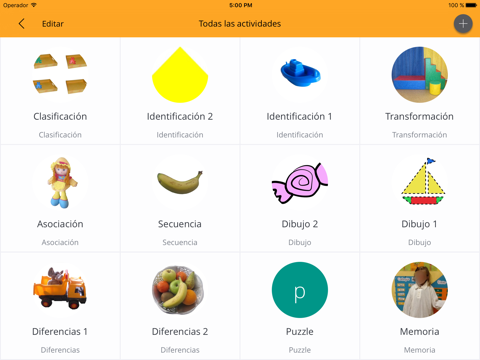
Eureka 1 application arises from the need to respond to the development of the basic mathematical competences of students with special educational needs, although it can be equally useful for early childhood education and first years of Primary Education.
It is an author tool, where it is the adult who selects the resources to configure, being the designer of all the activities, obtaining an individualized material and adapted to each situation and to each child, all using a highly motivating support as the iPad.
It combines the use of images and audios to make the learning of the different mathematical contents more attractive and intuitive. The contents that allow to work are linked to the concepts related to the objects that during these ages the students develop in the classroom. Thus we can create activities to work on concepts related to color, shape and size (attributes of objects), quantifiers and spatial and/or temporal relationships.
Eureka 1 has two modes of use: the mode corresponding to the tutor or professional (who designs the activities) and the student. It offers nine different types of basic activities in the intellectual development of children for the learning of mathematics. These activities respect the learning process of the student, that is, they are graduated in different stages or didactic moments. We can choose more primary activities such as ASSOCIATION or CLASSIFICATION, to end with activities such as MEMORY or DRAWING. The idea is to be able to choose the type of activity according to the moment or didactic stage in which the student finds himself to achieve mastery of a concept.
The following 9 types of activities are described below:
- ASSOCIATION: The student establishes a correspondence between objects according to a given criterion.
- CLASSIFICATION: The student establishes partitions or groupings based on a given criterion.
- IDENTIFICATION: The student identifies the attribute that is desired to work in a group of objects. It is allowed to select the affirmation and the negation of the attribute, which gives clarity in the domain of any mathematical concept.
- DIFFERENCES: The student compares the qualities or attributes of two objects. It allows to discriminate an unlimited number of differences. You can work with the two images on the screen or, to give more complexity because the student will use his short-term memory, with the images in the same plane.
- SEQUENCE: It refers to the temporary organization of an event.
- TRANSFORMATION: It allows to combine three parameters, position in space, size and angle. The student compares two scenes and must match them taking these parameters into account.
- PUZZLE: The puzzles are interesting exercises for the spatial development of the student. It is allowed to grade the degree of difficulty according to the number of pieces, if you want to work with guides, with the background image or if you allow the pieces to be transparent.
- MEMORY: The classic memory, adding the possibility of choosing to play with image-image or word/sound image, which will help the youngest to memorize the names of those concepts that have already worked.
- DRAWING: This activity is designed so that the student can compare two drawings, the one that we teach him and the one that he himself makes, being able to make comparisons of size, color or shape what is an application of the domain of the mathematical concept that you want to work.
For each of these types you can create as many activities as you wish, being the only limit the editors imagination. In addition, for each activity it is possible to configure an initial message (with the work order or statement of the activity) and a final reinforcement.
Finally, the activities can be grouped into collections defined by the editor according to the theme of the activity, the level, etc.



